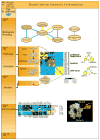Quantitative genetic interactions reveal biological modularity
- PMID: 20510918
- PMCID: PMC2946632
- DOI: 10.1016/j.cell.2010.05.019
Quantitative genetic interactions reveal biological modularity
Abstract
Traditionally, research has been reductionist, characterizing the individual components of biological systems. But new technologies have increased the size and scope of biological data, and systems approaches have broadened the view of how these components are interconnected. Here, we discuss how quantitative mapping of genetic interactions enhances our view of biological systems, allowing their deeper interrogation across different biological scales.
Copyright 2010 Elsevier Inc. All rights reserved.
Figures



Similar articles
-
Epistasis--the essential role of gene interactions in the structure and evolution of genetic systems.Nat Rev Genet. 2008 Nov;9(11):855-67. doi: 10.1038/nrg2452. Nat Rev Genet. 2008. PMID: 18852697 Free PMC article. Review.
-
Differential network biology.Mol Syst Biol. 2012 Jan 17;8:565. doi: 10.1038/msb.2011.99. Mol Syst Biol. 2012. PMID: 22252388 Free PMC article. Review.
-
Predicting Evolution Using Regulatory Architecture.Annu Rev Biophys. 2020 May 6;49:181-197. doi: 10.1146/annurev-biophys-070317-032939. Epub 2020 Feb 4. Annu Rev Biophys. 2020. PMID: 32040932 Review.
-
Modular analysis of biological networks.Adv Exp Med Biol. 2012;736:3-17. doi: 10.1007/978-1-4419-7210-1_1. Adv Exp Med Biol. 2012. PMID: 22161320 Review.
-
Systems biology of innate immunity.Immunol Rev. 2009 Jan;227(1):264-82. doi: 10.1111/j.1600-065X.2008.00721.x. Immunol Rev. 2009. PMID: 19120490 Free PMC article. Review.
Cited by
-
A lipid E-MAP identifies Ubx2 as a critical regulator of lipid saturation and lipid bilayer stress.Mol Cell. 2013 Aug 22;51(4):519-30. doi: 10.1016/j.molcel.2013.06.014. Epub 2013 Jul 25. Mol Cell. 2013. PMID: 23891562 Free PMC article.
-
Lineage-Specific Viral Hijacking of Non-canonical E3 Ubiquitin Ligase Cofactors in the Evolution of Vif Anti-APOBEC3 Activity.Cell Rep. 2015 May 26;11(8):1236-50. doi: 10.1016/j.celrep.2015.04.038. Epub 2015 May 14. Cell Rep. 2015. PMID: 25981045 Free PMC article.
-
SCS3 and YFT2 link transcription of phospholipid biosynthetic genes to ER stress and the UPR.PLoS Genet. 2012 Aug;8(8):e1002890. doi: 10.1371/journal.pgen.1002890. Epub 2012 Aug 23. PLoS Genet. 2012. PMID: 22927826 Free PMC article.
-
Epistatic relationships reveal the functional organization of yeast transcription factors.Mol Syst Biol. 2010 Oct 5;6:420. doi: 10.1038/msb.2010.77. Mol Syst Biol. 2010. PMID: 20959818 Free PMC article.
-
Mapping a diversity of genetic interactions in yeast.Curr Opin Syst Biol. 2017 Dec;6:14-21. doi: 10.1016/j.coisb.2017.08.002. Epub 2017 Aug 12. Curr Opin Syst Biol. 2017. PMID: 30505984 Free PMC article.
References
-
- Alber F, Dokudovskaya S, Veenhoff LM, Zhang W, Kipper J, Devos D, Suprapto A, Karni-Schmidt O, Williams R, Chait BT, et al. Determining the architectures of macromolecular assemblies. Nature. 2007;450:683–694. - PubMed
-
- Aloy P, Russell RB. Structural systems biology: modelling protein interactions. Nat Rev Mol Cell Biol. 2006;7:188–197. - PubMed
Publication types
MeSH terms
Substances
Grants and funding
LinkOut - more resources
Full Text Sources

